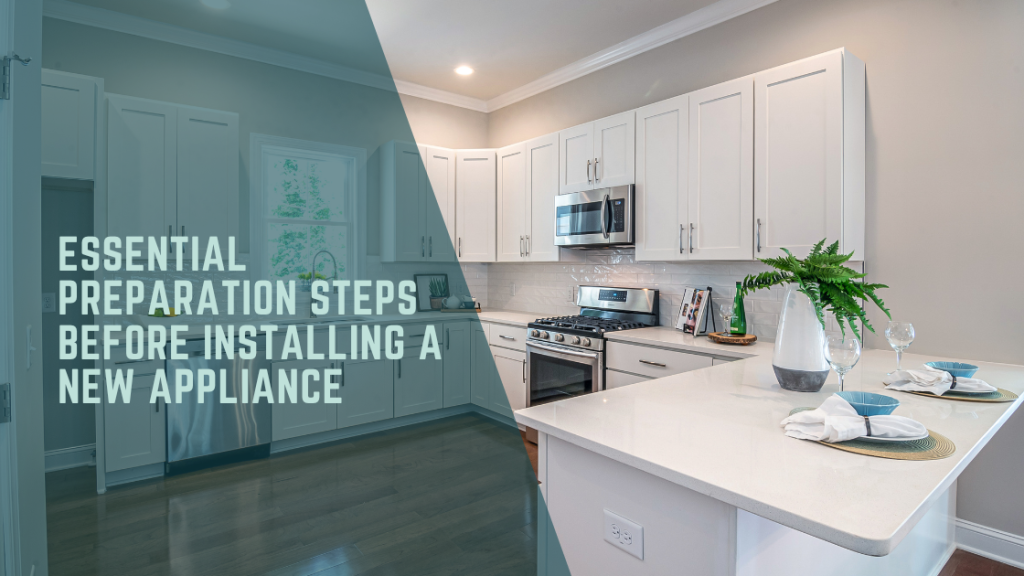Getting a new appliance always feels like an upgrade. Whether it’s a sleek refrigerator, a smart oven, or a quiet new washing machine, there’s something satisfying about bringing that modern convenience home. But before you unbox it and plug it in, a bit of preparation can make a huge difference. Many people rush into installation and end up with issues like uneven placement, electrical overloads, or damaged flooring. With a little planning, you can save yourself from stress and make sure your new appliance works perfectly from day one. If you prefer expert help from people who do this every day, you can also explore appliance installation pro for reliable, professional setup services.
Why Preparation Matters Before Installation
Installing an appliance might seem simple, but there’s a right way to do it. It’s not just about connecting wires or pipes; it’s about creating a safe, efficient, and long-lasting setup. Whether you’re doing it yourself or calling in pro appliance installers, knowing how to prepare your space helps avoid common mistakes and keeps your home running smoothly.
Step 1: Measure Everything Carefully
The first and most important step is to measure everything. This might sound obvious, but you’d be surprised how many people forget. Measure the area where your new appliance will go, noting its width, height, and depth. Leave extra space for ventilation and door movement.
If your fridge door can’t swing open all the way or your washing machine door hits the wall, that’s a problem you could have avoided. Also, measure hallways and entryways to make sure your new appliance can fit through when being delivered. If you’re unsure, write down the measurements or take a photo pro appliance installation teams always double-check this before moving a single item, and so should you.
Step 2: Check Electrical and Plumbing Connections
Next, check your electrical and plumbing connections. Every appliance has different requirements. Refrigerators, ovens, and dryers usually need their own dedicated electrical line, especially those that draw high voltage. A 220-volt connection might be necessary for larger appliances, while smaller ones work fine with a regular 110-volt outlet.
For appliances that use water, such as dishwashers or washing machines, inspect the hoses and connections for leaks or wear. It’s better to replace old or brittle hoses before connecting your new equipment. A few minutes of checking now can prevent a flooded floor later.
Step 3: Prepare the Installation Space
Once your utilities are ready, prepare the space. Remove the old appliance and clean underneath it. You might find dust, crumbs, or even water residue that can cause your new appliance to sit unevenly. Make sure the floor is level, especially for washers and dryers.
An uneven surface can cause vibration, noise, or even damage the appliance over time. If your floor isn’t level, use adjustable feet or shims to balance it properly. This simple step can make your appliance last much longer.
Step 4: Ensure Proper Ventilation
Another thing to consider is ventilation. Many large appliances generate heat or moisture that needs space to escape. Pushing your refrigerator tight against the wall can block air circulation and make it overheat. Similarly, dryers must have a proper vent leading outside; otherwise, humidity builds up and causes mold.
Leave a few inches of space behind your appliance for air to move freely. This small gap helps keep your energy bills lower and your machines working efficiently.
Step 5: Read the Manual Before Installation
Before installing anything, always read the manual. It’s not the most exciting part of the process, but it’s incredibly helpful. Each manufacturer includes detailed installation guidelines that explain everything from voltage requirements to clearance distances.
Even if you’ve installed similar appliances before, models can differ slightly. Reading the instructions ensures you don’t miss important details, especially those related to warranty or safety. If something isn’t clear, note your questions and check with your installer later. Pro appliance installers are familiar with most major brands and can easily clarify anything confusing.
Step 6: Turn Off Utilities Before Starting
When you’re ready to start, make sure all utilities are off. That means turning off power from the circuit breaker and closing any water valves. Skipping this step is dangerous and can lead to shocks or leaks.
If your appliance uses gas, always shut off the gas line completely before disconnecting or connecting anything. Gas work is best left to licensed technicians. Even a tiny leak can be hazardous, so don’t take chances.
Step 7: Gather the Right Tools
Having the right tools makes the whole process smoother. You’ll typically need a wrench, screwdriver set, tape measure, and level. For water connections, Teflon tape helps prevent leaks. For electrical work, make sure you have insulated tools.
Some appliances come with their own installation kits, which include hoses, clamps, and fittings. Keep everything within reach so you don’t have to stop halfway to find a missing screw.
While a bit of DIY can be rewarding, certain appliances like built-in microwaves, ovens, or complex gas ranges: require tools and skills that most homeowners don’t have. In those cases, calling professionals is the smart move.
Step 8: Test the Appliance
Once the appliance is installed, it’s time to test it. Plug it in, turn it on, and check that everything works as expected. Run a quick cycle if it’s a dishwasher or washing machine, or set the oven to preheat for a few minutes.
Make sure there are no leaks, noises, or vibrations that seem off. If something feels wrong, don’t ignore it. Addressing small issues early prevents bigger problems later. After everything checks out, clean the surrounding area, tuck away visible cords, and enjoy the satisfaction of a job well done.
Step 9: Keep Important Documents Organized
Don’t forget to organize your paperwork afterward. Keep your warranty, user manual, and receipt in one safe spot. If your appliance ever needs servicing, these documents will save you time and help you claim repairs under warranty.
Many people lose these papers and then struggle to prove their purchase or warranty coverage later on. Keeping them together is a simple but often overlooked part of good home maintenance.
Step 10: DIY or Hire a Professional?
Finally, decide if you want to go the DIY route or hire a professional. Doing it yourself can save a bit of money, but mistakes can cost more in the long run. Installing heavy or complicated appliances without the right tools can damage walls, floors, or the appliance itself.
Professional installation ensures everything is safe, balanced, and set up according to the manufacturer’s standards. A professional can also handle tricky connections, check for leaks, and make sure your new appliance is energy-efficient.
If you’re upgrading multiple appliances or setting up a new kitchen, professional help is especially worth it. You can always rely on appliance installation pro teams who handle everything from delivery and setup to safety checks and finishing touches. They’ll make sure your installation meets all safety standards, so you can start using your appliance worry-free.
Final Thoughts
Setting up a new appliance doesn’t have to be complicated, but it does take care and attention. The effort you put into preparation directly affects how well your appliance performs and how long it lasts. Whether you choose to handle it yourself or call pro appliance installers, doing it right the first time saves headaches down the road.
Before you hit that power button, take a few extra minutes to double-check everything. It’s the easiest way to protect your investment and keep your home running smoothly.



